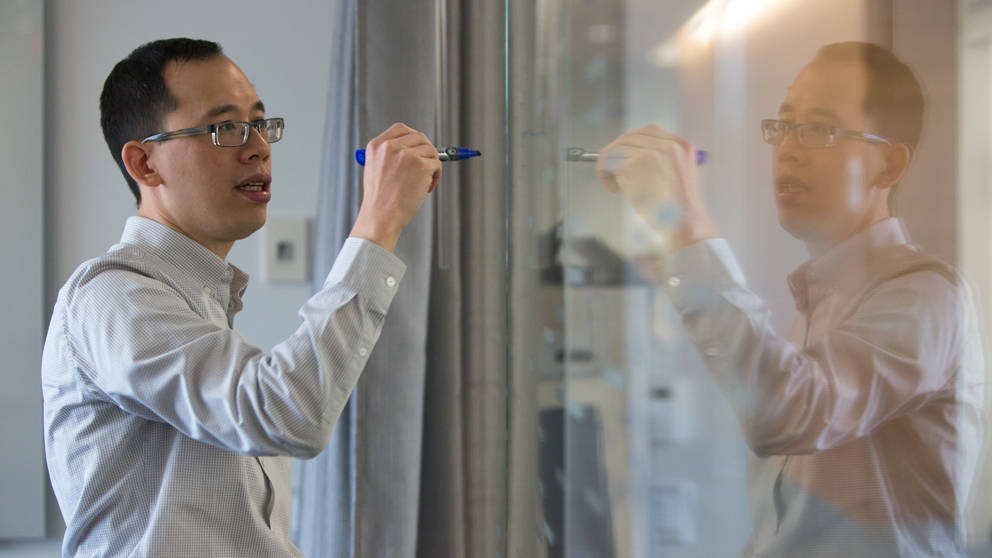
Jeff Chuang in his office at The Jackson Laboratory for Genomic Medicine. Photo by Tiffany Laufer.
Historically, most cancer research took place using cells in a dish, such as the famous “HeLa” immortal cell line, or cancers arising in model organisms such as mice. The limitations involved with such research, particularly for clinical applications, have come into sharper focus in recent years, however. While the research has provided a huge amount of biological insight, there are important differences between cancer cell lines, animal cancers, and human cancers within the human body.
To better model human cancers within the body, scientists developed patient derived xenograft (PDX) mice. Human tumor fragments, removed from patients during surgery, are engrafted in immunocompromised mice and grown and studied within an in vivo context. PDX mice make it far more feasible to investigate many clinical aspects of cancer, such as comparing the effects of alternative therapies on a single tumor, tracking cancer cell evolution in response to treatment, identifying possible biomarkers for drug response, and more. On the other hand, different institutions have used different procedures and analytical pipelines, making it difficult to assess how comparable and reproducible the results are.
To assess just how robust PDX research results are across procedures and institutions, a team of cancer researchers led by Jackson Laboratory Associate Professor Jeffrey Chuang, Ph.D.Computational studies of cancer image and sequence data to improve treatment outcomesJeff Chuang conducted experiments in multiple PDX Development and Trial Centers (PDTC). Chuang and five collaborating institutions in the PDXNet consortium, a group of PDX research centers supported by the National Cancer Institute (NCI), dosed three PDX mouse models—two with colon adenocarcinomas and one with urothelial/bladder cancer—with Temozolomide (also known as Temodal) using independently developed preclinical protocols. The models were chosen because of their known responses to Temozolomide treatment, but the research groups were blinded to the expected outcome.
In “Systematic Establishment of Robustness and Standards in Patient-Derived Xenograft Experiments and Analysis,” a paper published in Cancer Research, Chuang and the team show that even though the groups were not told what experimental protocol to use, the PDX research yielded accurate and consistent treatment response data in the context of a cytotoxic agent. While rigorous methodologies and analysis tools remain important, the team’s findings show that PDXs are robust enough to withstand the experimental variations that are common across laboratories. To synchronize these findings with approaches for PDX sequence analysis, the researchers developed standardized PDX sequence analysis pipelines for calling DNA variants in both tumor and normal tissues, as well as for evaluating RNA sequencing data. They have provided the tools on the Cancer Genomics Cloud (CGC) so that other researchers may access them when they also access data collections on the CGC.
PDX models provide a powerful preclinical platform for assessing therapy efficacy, tumor evolution and variability, and much more. Even without inter-institutional standards, much of the data being generated are reproducible. The results of the PDXNet consortium study provide a key validation toward translating xenograft findings into clinical treatments for patients.